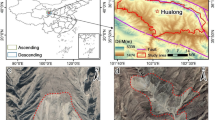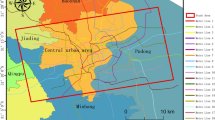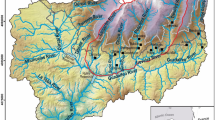Abstract
Gully erosion is widespread in central China's ecologically fragile loess plateau. However, research on the monitoring and evaluation of large-scale erosion is scarce. Here, we collected 16 pairs of Sentinel-1A images from the rainy season, spanning April 5-October 26, 2019, subsidence is then quantified and its results can indirectly reflect the intensity of erosion on the largest loess plateau in China, the Dongzhiyuan tableland, using small baseline subset synthetic aperture radar interferometry (SBAS-InSAR). The results showed that, the average erosion rate was 9 mm/year, throughout the study area, Surprisingly, the average erosion rate in the gully reached 160 mm/year, the sides of the gully correspond to the most extensive and intense erosion. Heavy rainfall, slope gradients below 15°, changes in groundwater levels due to freeze–thaw action and water infiltration during rainfall, and lack of vegetation due to continued gully side erosion, drive the intense erosion. These results demonstrate the reliable ability of the SBAS-InSAR method in accurately assessing large-scale gully erosion. The InSAR-calculated subsidence demonstrates a strong predictive capability for soil erosion and is generally consistent with previously observed levels of erosion, although much noise interference also occurs. Therefore, in the future InSAR-calculated sedimentation could be used as an indirect measure of erosion levels at multiple watershed scales.










Similar content being viewed by others
References
Addisie MB, Ayele GK, Gessess AA, Tilahun SA, Zegeye AD, Moges MM, Schmitter P, Langendoen EJ, Steenhuis TS (2017) Gully head retreat in the sub-humid ethiopian highlands: the ene-chilala catchment. Land Degrad Dev 28:1579–1588
Bastola S, Dialynas YG, Bras RL, Noto LV, Istanbulluoglu E (2018) The role of vegetation on gully erosion stabilization at a severely degraded landscape: a case study from Calhoun Experimental Critical Zone Observatory. Geomorphology 308:25–39
Belayneh M, Yirgu T, Tsegaye D (2020) Current extent, temporal trends, and rates of gully erosion in the Gumara watershed. Northwestern Ethiopia Global Ecol Conserv 24:e01255
Berardino P, Fornaro G, Lanari R, Sansosti E (2002) A new algorithm for surface deformation monitoring based on small baseline differential SAR interferograms. IEEE Trans Geosci Remote Sens 40:2375–2383
Castillo C, Perez R, James MR, Quinton JN, Taguas EV, Gomez JA (2012) Comparing the accuracy of several field methods for measuring gully erosion. Soil Sci Soc Am J 76:1319–1332
Chen DH, Chen HE, Zhang W, Cao C, Zhu KX, Yuan XQ, Du YY (2020) Characteristics of the residual surface deformation of multiple abandoned mined-out areas based on a field investigation and SBAS-InSAR: a case study in jilin China. Remote Sens 12:17
Chou YL, Wang LJ (2021) Seasonal freezing-thawing process and hydrothermal characteristics of the soil on the Loess Plateau, China. J Mt Sci 18:3082–3098
Dickson JL, Head JW, Kreslavsky M (2007) Martian gullies in the southern mid-latitudes of Mars: evidence for climate-controlled formation of young fluvial features based upon local and global topography. Icarus 188:315–323
Douglas-Mankin KR, Roy SK, Sheshukov AY, Biswas A, Gharabaghi B, Binns A, Rudra R, Shrestha NK, Daggupati P (2020) A comprehensive review of ephemeral gully erosion models. Catena 195:10
Du WB, Ji WQ, Xu LJ, Wang ST (2020) Deformation time series and driving-force analysis of glaciers in the eastern tienshan mountains using the SBAS InSAR method. Int J Environ Res Public Health 17:18
Fan XM, Xu Q, Scaringi G, Li S, Peng DL (2017) A chemo-mechanical insight into the failure mechanism of frequently occurred landslides in the Loess Plateau, Gansu Province, China. Eng Geol 228:337–345
Ferretti A, Prati C, Rocca F (2000) Nonlinear subsidence rate estimation using permanent scatterers in differential SAR interferometry. IEEE Trans Geosci Remote Sens 38:2202–2212
Gao HD, Li ZB, Jia LL, Li P, Xu GC, Ren ZP, Pang GW, Zhao BH (2016) Capacity of soil loss control in the Loess Plateau based on soil erosion control degree. J Geog Sci 26:457–472
Guan YB, Yang ST, Zhao CS, Lou HZ, Chen K, Zhang CB, Wu BW (2021) Monitoring long-term gully erosion and topographic thresholds in the marginal zone of the Chinese Loess Plateau. Soil Tillage Res 205:13
Guo MM, Wang WL, Shi QH, Chen TD, Kang HL, Li JM (2019) An experimental study on the effects of grass root density on gully headcut erosion in the gully region of China's Loess Plateau. Land Degrad Dev 30:2107–2125
Guo MM, Chen ZX, Wang WL, Wang TC, Wang WX, Cui ZQ (2021) Revegetation induced change in soil erodibility as influenced by slope situation on the Loess Plateau. Sci Total Environ 772:15
Haregeweyn N, Tsunekawa A, Poesen J, Tsubo M, Meshesha DT, Fenta AA, Nyssen J, Adgo E (2017) Comprehensive assessment of soil erosion risk for better land use planning in river basins: case study of the upper blue Nile River. Sci Total Environ 574:95–108
Hu S, Qiu HJ, Wang NL, Wang XG, Ma SY, Yang DD, Wei N, Liu ZJ, Shen YD, Cao MM, Song ZP (2022) Movement process, geomorphological changes, and influencing factors of a reactivated loess landslide on the right bank of the middle of the Yellow River, China. Landslides 19:1265–1295
Huang DH, Su L, Zhou LL, Tian YL, Fan HM (2023) Assessment of gully erosion susceptibility using different DEM-derived topographic factors in the black soil region of Northeast China. Int Soil Water Conserv Res 11:97–111
Huo AD, Peng JB, Cheng YX, Luo PP, Zhao ZX, Zheng CL (2020) Hydrological analysis of loess plateau highland control schemes in dongzhi plateau. Front Earth Sci 8:14
Jiang CC, Fan W, Yu NY, Liu EL (2021) Spatial modeling of gully head erosion on the Loess Plateau using a certainty factor and random forest model. Sci Total Environ 783:13
Kou PL, Xu Q, Yunus AP, Liu J, Xu YL, Wang CL, Li HJ, Wei Y, Dong XJ (2020) Landslide-controlled soil erosion rate in the largest tableland on the Loess Plateau, China. Hum Ecol Risk Assess 26:2478–2499
Li CB, Qi JG, Wang SB, Yang LS, Yang WJ, Zou SB, Zhu GF, Li WY (2014) A holistic system approach to understanding underground water dynamics in the loess tableland: a case study of the dongzhi loess tableland in Northwest China. Water Resour Manag 28:2937–2951
Li Z, Zhang Y, Zhu QK, Yang S, Li HJ, Ma H (2017) A gully erosion assessment model for the Chinese Loess Plateau based on changes in gully length and area. Catena 148:195–203
Ling XY, Ma JZ, Chen PY, Liu CJ, Horita J (2022) Isotope implications of groundwater recharge, residence time and hydrogeochemical evolution of the Longdong Loess Basin, Northwest China. J Arid Land 14:34–55
Liu YF, Fan HD, Wang L, Zhuang HF (2021) Monitoring of surface deformation in a low coherence area using distributed scatterers InSAR: case study in the **aolangdi Basin of the Yellow River, China. Bullet Eng Geol Environ 80:25–39
Meng ZJ, Ma PH, Peng JB (2021) Characteristics of loess landslides triggered by different factors in the Chinese Loess Plateau. J Mt Sci 18:3218–3229
Meng ZG, Shu CZ, Yang Y, Wu CZ, Dong XG, Wang DZ, Zhang YZ (2022a) Time series surface deformation of changbaishan volcano based on sentinel-1B SAR data and its geological significance. Remote Sens 14:22
Meng ZG, Shu CZ, Yang Y, Wu CZ, Dong XG, Wang DZ, Zhang YZ (2022b) Time series surface deformation of changbaishan volcano based on sentinel-1B SAR data and its geological significance. Remote Sens 14:22
Pei YQ, Qiu HJ, Yang DD, Liu ZJ, Ma SY, Li JY, Cao MM, Wufuer W (2023) Increasing landslide activity in the Taxkorgan River Basin (eastern Pamirs Plateau, China) driven by climate change. Catena 223:11
Pu CH, Xu Q, Zhao KY, Jiang YN, Hao LN, Liu JL, Chen WL, Kou PL (2021) Characterizing the topographic changes and land subsidence associated with the mountain excavation and City construction on the Chinese loess Plateau. Remote Sens 13:20
Qin X, Zhu HS, Ren YQ, Cao ZR, Wang X, Zhao ZN, Yao YF, Zhong ZK, Kong WB, Qiu Q, Jia HT, Wei XR (2022) Erosion intensity and check dam size affect the horizontal and vertical distribution of soil particles, carbon and nitrogen: evidence from China’s Loess Plateau. Catena 217:8
Raj R, Yunus AP, Pani P, Avtar R (2022) Towards evaluating gully erosion volume and erosion rates in the Chambal badlands, Central India. Land Degrad Dev 33:1495–1510
Shi QH, Wang WL, Zhu BC, Guo MM (2020) Experimental study of hydraulic characteristics on headcut erosion and erosional response in the tableland and gully regions of China. Soil Sci Soc Am J 84:700–716
Su XJ, Zhang Y, Meng XM, Yue DX, Ma JH, Guo FY, Zhou ZQ, Rehman MU, Khalid Z, Chen G, Zeng RQ, Zhao FM (2021) Landslide map** and analysis along the China-Pakistan Karakoram Highway based on SBAS-InSAR detection in 2017. J Mt Sci 18:2540–2564
Su XJ, Zhang Y, Meng XM, Rehman MU, Khalid Z, Yue DX (2022) Updating inventory, deformation, and development characteristics of landslides in Hunza Valley, NW Karakoram. Pakistan SBAS-InSAR Remote Sens 14:27
Sun LY, Zhou JL, Cai QG, Liu SX, **ao JA (2021) Comparing surface erosion processes in four soils from the Loess Plateau under extreme rainfall events. Int Soil Water Conserv Res 9:520–531
Tang J, Liu G, **e Y, Wu YQ, Wang D, Gao Y, Meng LQ (2022) Effect of topographic variations and tillage methods on gully erosion in the black soil region: a case-study from Northeast China. Land Degrad Dev 33:3786–3800
Wang R, Zhang S, Pu L, Yang J, Yang C, Chen J, Guan C, Wang Q, Chen D, Fu B, Sang X (2016) Gully erosion map** and monitoring at multiple scales based on multi-source remote sensing data of the Sancha river catchment. Northeast China 5:200
Wang R, Li P, Li ZB, Yu KX, Han JC, Zhu YB, Su YY (2021) Effects of gully head height and soil texture on gully headcut erosion in the Loess Plateau of China. Catena 207:11
Wei YJ, Liu Z, Zhang Y, Cui TT, Guo ZL, Cai CF, Li ZX (2022) Analysis of gully erosion susceptibility and spatial modelling using a GIS-based approach. Geoderma 420:14
Wu B, Wang ZL, Zhang QW, Shen N, Liu J (2017) Modelling sheet erosion on steep slopes in the loess region of China. J Hydrol 553:549–558
Wu Q, Jia CT, Chen SB, Li HQ (2019) SBAS-InSAR based deformation detection of urban land, created from mega-scale mountain excavating and valley filling in the loess plateau: the case study of Yan'an city. Remote Sens 11:20
**ong LY, Li SJ, Hu GH, Wang K, Chen M, Zhu AX, Tang GA (2023) Past rainfall-driven erosion on the Chinese loess plateau inferred from archaeological evidence from Wucheng City, Shanxi. Commun Earth Environ 4:8
Xu L, Coop MR, Zhang M, Wang G (2018) The mechanics of a saturated silty loess and implications for landslides. Eng Geol 236:29–42
Zabihi M, Mirchooli F, Motevalli A, Khaledi Darvishan A, Pourghasemi HR, Zakeri MA, Sadighi F (2018) Spatial modelling of gully erosion in Mazandaran Province, northern Iran. Catena 161:1–13
Zhang SH, Li YQ, Fan WW, Yi YJ (2017) Impacts of rainfall, soil type, and land- use change on soil erosion in the Liusha river watershed. J Hydrol Eng 22:11
Zhang J, Wang N, Wang Y, Wang L, Hu A, Zhang D, Su X, Chen J (2021) Responses of soil erosion to land-use changes in the largest tableland of the Loess Plateau. Land Degrad Dev 32:3598–3613
Zhang HF, Wang L, Zhao YF, Cao JC, Xu M (2022) Application of airborne LiDAR measurements to the topographic survey of the tidal flats of the Northern Jiangsu radial sand ridges in the Southern Yellow Sea. Front Mar Sci 9:13
Zhou YF, Tham LG, Yan RWM, Xu L (2014) The mechanism of soil failures along cracks subjected to water infiltration. Comput Geotech 55:330–341
Zhou WQ, Qiu HJ, Wang LY, Pei YQ, Tang BZ, Ma SY, Yang DD, Cao MM (2022) Combining rainfall-induced shallow landslides and subsequent debris flows for hazard chain prediction. Catena 213:11
Zhuang JQ, Ma PH, Zhan JW, Zhu Y, Kong JX, Zhu XH, Leng YQ, Peng JB (2022) Empirical relationships of the landslides in the Chinese loess plateau and affect factors analysis. Geomat Nat Haz Risk 13:250–266
Funding
This research was funded by The Science and Technology Research Project of Chongqing Municipal Education Commission, grant number KJQN202100624, and The Science and Technology Research Program of Chongqing Municipal Education Commission, grant number KJQN201900628.
Author information
Authors and Affiliations
Contributions
Yuxiang Tao contributed to conceptualization; **aobo Luo contributed to data curation; Yongcheng Gou contributed to investigation; Haibo Tian and **lang Kou contributed to methodology; Haibo Tian and **lang Kou contributed to software; Haibo Tian contributed to visualization; Haibo Tian contributed to writing—original drafts; Yuxiang Tao, **lang Kou, Andres Alonso, Haibo Tian, Chenyu Gong, Yunpeng Fan, Changjian Lei contributed to writing—review and editing. All authors have read and agreed to the published version of the manuscript.
Corresponding author
Ethics declarations
Conflicts of interest
The authors declare that they have no known competing financial interests or personal relationships that could have appeared to influence the work reported in this paper.
Additional information
Publisher's Note
Springer Nature remains neutral with regard to jurisdictional claims in published maps and institutional affiliations.
Rights and permissions
Springer Nature or its licensor (e.g. a society or other partner) holds exclusive rights to this article under a publishing agreement with the author(s) or other rightsholder(s); author self-archiving of the accepted manuscript version of this article is solely governed by the terms of such publishing agreement and applicable law.
About this article
Cite this article
Tian, H., Tao, Y., Kou, P. et al. Monitoring and evaluation of gully erosion in China's largest loess tableland based on SBAS-InSAR. Nat Hazards 117, 2435–2454 (2023). https://doi.org/10.1007/s11069-023-05950-x
Received:
Accepted:
Published:
Issue Date:
DOI: https://doi.org/10.1007/s11069-023-05950-x




